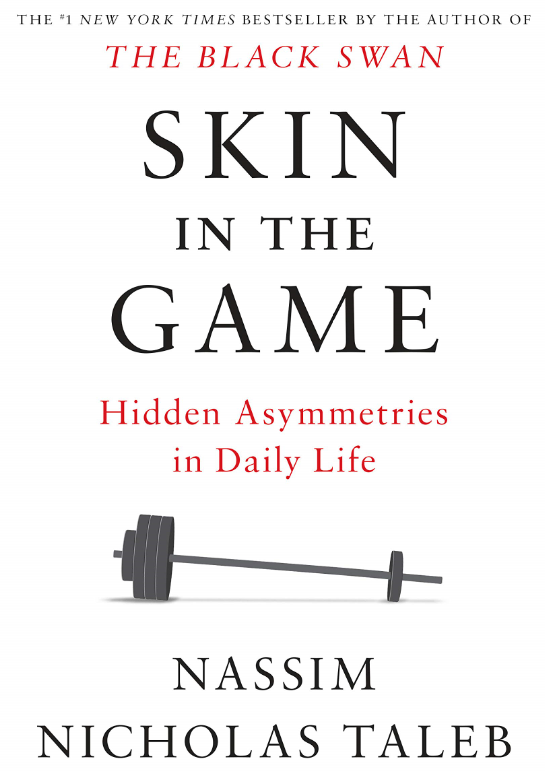Skin in the Game
What is the optimal level of investment for a GP to have in her strategy? This is a difficult question to answer. It touches fundamental issues underlying principal / agent relationships. Perhaps the most en vogue answer today comes from the writings of Nicholas Nassim Taleb. Taleb is the author of “Skin in the Game” (2018) amongst other polemics on risk and probability. This piece highlights the importance of alignment of interest in risk-taking. His classical example is the Roman architect who must stand underneath a completed arch first, risking his life before it risks the lives of others as a public utility. More tangibly, he notes how diversified financial institutions were able to abdicate the downside cost of their risk taking while enjoying fantastic renumeration in the run-up to the global financial crisis.
Taleb’s framework stresses symmetric alignment. Not only should a fund manager be wholly invested in her strategy, the risk to clients must be equitable, avoiding ‘heads-I-win, tails-you-lose’ dynamics. These do occur in hedge funds as a function of incentive fees and assymetries of wealth. E.g., I harvest 20% of profits from you in good years, I get paid nothing in bad years, but have the option to close shop and walk away with crystalized profits and a family office, to boot.
There’s one fundamental problem with applying Taleb’s approach holistically to active fund management: veritably all institutional allocators view a single fund manager as a small part of their overall asset allocation. As a result, the management of risk for the endowment of pension is globally different than the management of risk for the general partner, especially if the entirety of their net worth is placed into the fund or strategy. Put another way, allocators should manage risk globally, while Skin in the Game fund managers will be pushed to manage risk locally.
The two interact in interesting ways. From our vantage, we have increasingly seen institutional allocators embracing the notion of global risk management. Practically speaking, that means any single allocation to a fund or strategy may have a risk profile beyond the tolerance of the aggregate plan, while still meriting an allocation. This is sensible, just as any single security owned by a fund manager may be too risky to place the entirety of net assets into but may improve the aggregate risk-adjusted return.
The corollary of this realization has been increased concentration profiles from new fund launches. While there are confluent driveres behind this (including the commodification of beta), the truth is allocators don’t want fund managers to diversify away portfolio risk with index-hugging exposure for fear of an elevated volatility profile. They want the focus of the fund manager to be on idiosyncratic risks, where the expert can ply her trade in generating alphas. As a result, these fund manager’s may have 25-50% of their NAV in a single idea, versus the colloquial ‘high conviction’ weighting of 5-7% for diversified strategies of yester-year.
But when you have 50% of your fund in a single idea, you are moving to the realm of probabilities at the corporate level, rather than the portfolio level. Even the best investment idea runs the risk of underperformance given the uncertainty associated with reaching for alpha. This is tautological: if there was certainty behind excess return, it would be arbitraged away. As such, with hyper-concentration comes fatter tailed risks associated with renumeration, career risk, and personal wealth of the fund manager. Where that risk was historically diversified within her strategy, it is now being diversified one level above: at the allocator level. What may be a perfectly suitable investment for an endowment may be a recipe for disaster as a driver of one’s entire net worth.
Going back to alignment, things can get wacky pretty quickly. If said fund manager enjoys success and raises assets in the strategy (as well as personal wealth), it becomes increasingly difficult to continue investing in such a concentrated manner if one’s entire net worth is still allocated to the strategy. It would be patently illogical for them to do so.
Now, some allocators attempt to work around this. They do so by finding fund managers who invest not for material wealth but for the thrill of the competition, or the gratification behind mastery of a particularly challenging game. But that doesn’t address the fundamental issue of global versus local risk being mis-aligned by Skin in The Game.
There is no easy answer to this problem just as there is no one size fits all shoe. But there are some general principles that drive our thinking on the matter:
- Think about contractual structures that change with the evolution of a firm’s profile. What was appropriate at t0 may no longer be appropriate at tn. This is because initial conditions evolve, such as notoriety, personal wealth, or strategy size. Recognizing this beforehand can allow for intelligent structuring of principal/agent dilemmas.
- Incentive fees on profits should be succeeded by incentive fees on alpha. While the common trope of ‘you can’t eat alpha’ resonates with some, alpha drives better alignment than profits when it comes to principal/agent problems.
- Claw backs became a focal point in firms with their own internal principal-agent issues (e.g., multi-manager funds), but their practice is more nuanced and messier than the surface may suggest when dealing with a single strategy allocation.
- Hybrid models where GPs also run sidecar vehicles (e.g., ‘internal fund-of-funds’) have merit, even though they feel like relics of the past. If structured thoughtfully, they allow the GP to diversify their personal risk gradually, while simulataneously increasing the strength and visibility of their network.
—-
The information contained in this article was obtained from various sources that Epsilon Asset Management, LLC (“Epsilon”) believes to be reliable, but Epsilon does not guarantee its accuracy or completeness. The information and opinions contained on this site are subject to change without notice.
Neither the information nor any opinion contained on this site constitutes an offer, or a solicitation of an offer, to buy or sell any securities or other financial instruments, including any securities mentioned in any report available on this site.
The information contained on this site has been prepared and circulated for general information only and is not intended to and does not provide a recommendation with respect to any security. The information on this site does not take into account the financial position or particular needs or investment objectives of any individual or entity. Investors must make their own determinations of the appropriateness of an investment strategy and an investment in any particular securities based upon the legal, tax and accounting considerations applicable to such investors and their own investment objectives. Investors are cautioned that statements regarding future prospects may not be realized and that past performance is not necessarily indicative of future performance.


